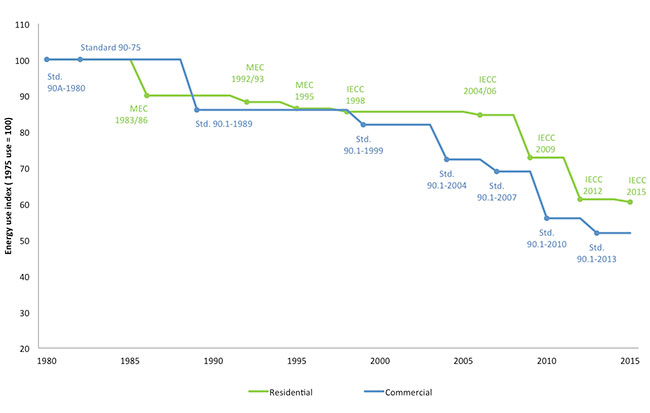Building codes have protected people with minimum health and safety requirements for buildings since the Code of Hammurabi in 1754 BCE. Energy provisions in US codes have protected owners and tenants from excessive energy waste since the 1970s. They set minimum performance levels for energy features in new buildings and renovations, notably insulation, windows, air sealing, and to some extent, lighting and heating and cooling equipment.
Most building energy codes in this country are set by states, based on model codes developed by independent organizations. For homes, this is usually the International Energy Conservation Code (IECC), developed by an organization of code officials called the International Code Council. For commercial buildings, the federal government recognizes ASHRAE Standard 90.1, developed by a professional society of engineers. The code development process is complex. After some early progress, energy codes languished through most of the 1990s.
However, in the last decade energy savings in the model codes have been so dramatic that the lines in the graph look like cliffs, or at least water slides. These advances were spurred by savings goals adopted by ASHRAE, the Department of Energy (under President Bush), and outside groups, in part due to concerns about climate change. The rapid progress was enabled by better technologies and building methods that allow cost-effective savings, such as tighter building shells, improved insulation, low-e windows, and new kinds of lighting.
Relative Energy Use under Model Building Energy Codes 1980-2015
Source: ACEEE based on analysis from Pacific Northwest National Laboratory
The graph shows the energy use of a home or building that just meets the respective codes, averaged across building types and regions, compared to a similar home or building from the 1970s. Energy use estimates are based on building simulations and analysis by Pacific Northwest National Laboratory. For commercial buildings the graph includes all energy use. But for homes it just includes energy use affected by the code, mostly for heating and cooling; the percentage change in total home energy use would be smaller than that shown. Between 2008 and 2012, energy use covered under the residential model code dropped 32%. Between 2003 and 2013, total energy use for a building that meets the commercial model code dropped 37%.
Even though codes in many states are far behind the national models, the effect of codes has been dramatic. Average energy use per household has gone down even as houses have gotten bigger and the use of air conditioning and electronics has shot up. We estimate the most recent codes, if implemented nationwide, would save about $150 billion (net present value after needed investments), reduce total energy use in buildings nationwide by 5% in 2030, and create tens of thousands of jobs. We just need states to jump on the slide.
For more on the potential for building energy codes to transform energy use, see the ACEEE report Energy Codes for Ultra-Low Energy Buildings: A Critical Pathway to Zero Net Energy Buildings.
Data Points is a blog series focusing on the graphs and other images that tell the energy efficiency story.




